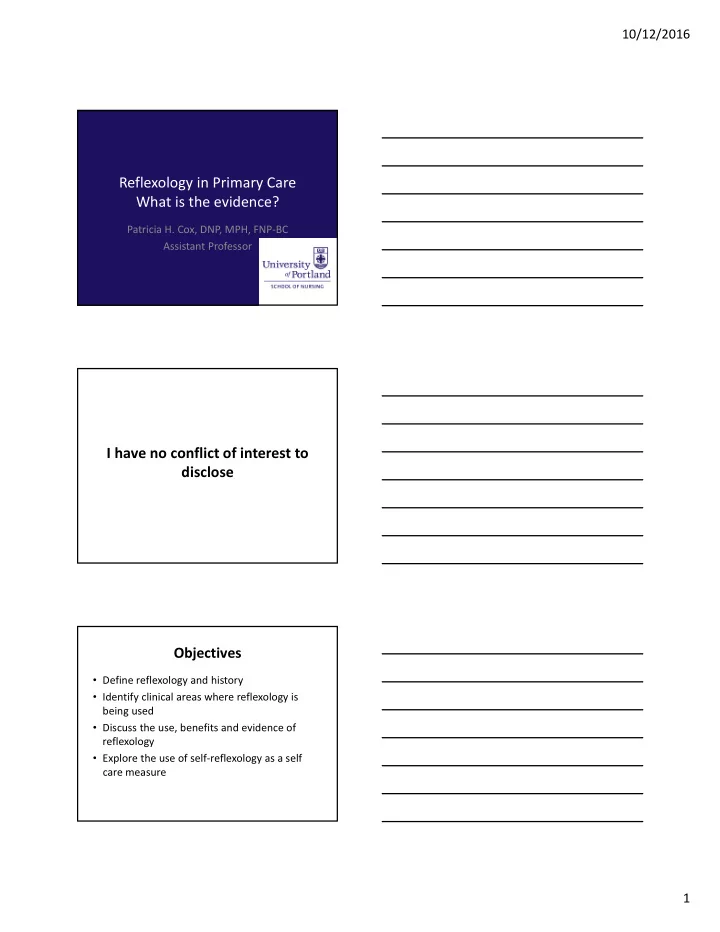

10/12/2016 Reflexology in Primary Care What is the evidence? Patricia H. Cox, DNP, MPH, FNP ‐ BC Assistant Professor I have no conflict of interest to disclose Objectives • Define reflexology and history • Identify clinical areas where reflexology is being used • Discuss the use, benefits and evidence of reflexology • Explore the use of self ‐ reflexology as a self care measure 1
10/12/2016 What is reflexology? Whoa….what does that all mean? 2
10/12/2016 Reflexology • The entire body is reflected on the feet, hands and ears. • Non ‐ invasive complementary discipline employing alternating pressure on body maps on the feet, hands and ears. • Reduces stress which causes physiological changes in the body. • Provides relaxation which may help the body balance. Foot Reflexology Hand Reflexology 3
10/12/2016 Brief History Brief History • Believed to have started in Egypt, Tibet, China and/or with Native American Indians. • There is no proof but art and sculptures of indigenous cultures do indicate working on the feet. • The first use of the word ‘reflex’ with reference to motor reactions was by the German physiologist Johann August Unzer in 1771. 4
10/12/2016 Brief History • Fitzgerald, the father of ‘zone therapy’, divided the body into ten zones—five on each side of the sagittal plane. • Doctors and dentists used as a form of pain relief or analgesia. • Riley, began reflexology as known today, reflexes found on feet and hands follow the anatomy of the body. • In 1930 Eunice Ingham contributed that alternating pressure stimulated healing. What is reflexology used for? • Anxiety • Asthma • Cancer treatment • Cardiovascular issues • Diabetes • Headaches • Kidney function • PMS • Sinusitis • Palliative care & Hospice What are the benefits of reflexology? • It promotes stress reduction throughout the entire body, bringing about relaxation • It naturally promotes balance and normalizations of the body through the relaxation process • It stimulates circulation and the delivery of oxygen and nutrients to the cells. 5
10/12/2016 What is the evidence? Kunz & Kunz (2008) summarized 168 research studies and abstracts from journals and meetings from around the world. Many in peer ‐ reviewed journals in China and Korea. All had information about the frequency and duration of the reflexology application. They concluded that reflexology may: Impact specific organs (e.g., fMRI readings demonstrated an increase in • blood flow to kidneys and to the intestines) Be associated with an amelioration of symptoms (e.g., positive changes • were noted in kidney functioning with kidney dialysis patients) Create a relaxation effect (e.g., EEGs measure alpha and theta waves, • blood pressure was decreased, and anxiety was lowered) Aid in pain reduction (27 studies demonstrated a positive outcome for • reduction in pain; e.g., AIDS, chest pain, peripheral neuropathy of diabetes mellitus, kidney stones, and osteoarthritis) What is the evidence? Other systematic reviews are cautious: • reflexology may have a positive effect on type 2 diabetes • may exert a beneficial effect of lowering blood pressure and incontinence(Song, 2015) • may have a positive impact on blood pressure (McCullough, 2014) • may be effective for tingling in MS(Yadav, 2015). These reviews note that the quality of research studies on reflexology is generally low. What is the evidence? Ernst, Posadzki & Lee (2011) conducted a systematic review. They evaluated the effectiveness of reflexology in the treatment of human conditions. Twenty ‐ three RCTs met their inclusion criteria: • 8 suggested that reflexology had beneficial effects • 14 showed no effectiveness • one was equivocal. The authors note that the quality of the studies was often poor. 6
10/12/2016 The Bottom Line Studies in the U.S. and around the world indicate possible benefits of reflexology for various conditions: • as an intervention to reduce pain • enhance relaxation • reduce psychological symptoms, such as anxiety and depression. However, reviewers of the research have noted that the quality of reflexology studies is mixed and more high ‐ quality research is needed. Is reflexology safe? Reflexology is a safe healing practice however there are a few contraindications: • foot fractures, unhealed wounds, or active gout in the foot. • osteoarthritis of the foot or ankle • vascular disease of the legs or feet • current thrombosis or embolism • women in early pregnancy (the first 6 weeks). Caution should be exercised during pregnancy because of reports that stimulation may cause contractions. • allow at least 48 hours between touch therapy sessions to avoid an overload on your system. What are the guiding principles in reflexology? • Reflexologists do not heal clients; the body repairs itself. • Reflexology is offered to help bring the person back into balance so that the body can nurture and repair itself. • A relaxed body can induce calm emotions, a serene mind, and an integrated spirit. • The body responds to touch, which can facilitate healing on all levels. 7
10/12/2016 Self ‐ reflexology as self ‐ care https://www.youtube.com/watch?v=VIiO7WOw rgk Finally "If you're feeling out of kilter. Don't know why or what about. Let your feet reveal the answer. Find the sore spot work it out." Eunice D. Ingham The Law & Reflexology Oregon • 851 ‐ 050 ‐ 0005 Nurse Practitioner Scope of Practice (8) The nurse practitioner will only provide health care services within the nurse practitioner's scope of practice for which he/she is educationally prepared and for which competency has been established and maintained. Educational preparation includes academic coursework, workshops or seminars, provided both theory and clinical experience are included. 8
Recommend
More recommend